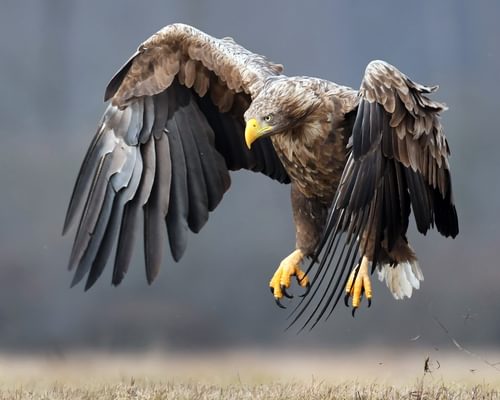Golden Eagle
Least ConcernAquila chrysaetos
Visual Identification
Appearance
The Golden Eagle is a majestic raptor with dark brown plumage and golden-brown feathers on the head and neck. Adults have a wingspan of up to 2.3 meters, with females typically larger than males. Key features include a powerful hooked beak and yellow feet with sharp talons.
Juveniles are distinguished by white patches on their wings and tail base. As they mature, their plumage darkens, and they develop the characteristic golden nape. Adults maintain consistent plumage year-round.
Size
Length
66cm to 102cm
Wingspan
180cm to 230cm
Weight
3kg to 6.7kg
Colours
Males and females have similar plumage
Primary Colour
Brown Black
Beak Colour
Grey
Leg Colour
Yellow
Habitat and Distribution
Habitats
Woodland
Garden
Wetland
Coastal
Urban
Farmland
Grassland
Desert
Tundra
Rainforest
Mountain
Savanna
Distribution
Golden Eagles inhabit open and semi-open areas, including mountains, hills, grasslands, and tundra. They are found across the Northern Hemisphere, including North America, Europe, and Asia. In North America, they are most common in western states and Alaska.
Some populations move to lower elevations or more southerly regions during winter. However, they are year-round residents in parts of their range with suitable habitat and prey availability.
Golden Eagles have an extensive range in North America, from Alaska in the north to Mexico in the south. In the UK, Golden Eagles are confined mainly to the hillsides and glens of the Scottish Highlands and Islands.
Elevation Range
Sea level to 4,000 meters
Climate zones
Temperate, Subarctic, Alpine
Distribution Map
This map gives you a rough idea of where you might spot a Golden Eagle. The coloured areas show countries where these birds have been seen.
A few things to keep in mind:
- Birds might not be everywhere in the coloured areas, for example, they may be present around the coast of that country
- Where birds live can change with seasons and available food
- This map is quite simple - it doesn't show exact locations
We're working on making our maps even better! Soon, we hope to show you:
- More detailed maps for bigger countries, including state and region
- How birds move around during different seasons
Distribution by Region
Behaviour and Ecology
Bird Attributes
This feature is in beta. We'd love your feedback to improve it!
Share your thoughtsBird Attributes Explained
Our bird attributes system rates various aspects of a bird's capabilities on a scale of 0-100, based on data from field observations, scientific studies, and expert knowledge.
Attribute Categories:
- Agility: Manoeuvrability, speed, and grace in flight or movement.
- Strength: Physical power, often correlating with size and hunting abilities.
- Adaptability: Ability to thrive in various environments or changing conditions.
- Aggressiveness: Territorial behaviour and assertiveness, particularly during breeding seasons.
- Endurance: Stamina, often seen in migration patterns or foraging behaviours.
Understanding the Ratings:
- 0-20: Very Low
- 21-40: Low
- 41-60: Average
- 61-80: High
- 81-100: Very High
Remember, these attributes are relative to other bird species and don't necessarily indicate superiority.
Hover over the icon next to each attribute for more information.
Tap the icon next to each attribute for more information.
Agility
Reflects the bird's manoeuvrability, speed, and grace in flight or movement.
Golden Eagles possess remarkable agility, demonstrated by their ability to perform spectacular aerial displays during courtship, including cartwheels and synchronized diving. Their skill in manoeuvring through the air, coupled with diving speeds of up to 240 km/h when hunting, showcases their exceptional agility.
Strength
Indicates the bird's physical power, often correlating with size and hunting abilities.
These raptors exhibit tremendous strength, capable of capturing prey much larger than themselves, including foxes and young deer. Their powerful talons and ability to carry substantial quarry over distances reflect their formidable physical strength.
Adaptability
Represents the bird's ability to thrive in various environments or changing conditions.
Golden Eagles show high adaptability, thriving in diverse habitats from sea level to 4,000 metres elevation. Their ability to inhabit various biomes including mountains, grasslands, and woodlands, as well as their partial migratory behaviour, indicates strong adaptability to different environments and conditions.
Aggressiveness
Measures the bird's territorial behaviour and assertiveness, particularly during breeding seasons.
While not typically aggressive towards humans, Golden Eagles are fierce predators. Their hunting behaviour, ability to take large prey, and readiness to defend their territory and nests suggest a high level of aggression in certain contexts, particularly related to hunting and breeding.
Endurance
Reflects the bird's stamina, often seen in migration patterns or foraging behaviours.
The Golden Eagle's endurance is evident in its ability to soar for extended periods on thermal currents and its long-distance hunting forays. Their partial migratory nature and capacity to thrive in harsh environments, from subarctic to alpine climates, further demonstrate their impressive endurance.
Diet
Golden Eagles are opportunistic predators. They primarily hunt mammals like rabbits, hares, and marmots. They also take birds, reptiles, and occasionally fish.
These powerful raptors can capture prey as large as foxes and young deer, using their strong talons to subdue and carry their quarry. They readily feed on animal carcasses, including those killed by other carnivores.
Behaviour
Golden Eagles are solitary birds, often seen soaring on thermal currents with their wings held in a slight V-shape. They are skilled hunters, capable of taking prey much larger than themselves.
During courtship, pairs perform spectacular aerial displays, including cartwheels and synchronized diving.
Vocalisation
Golden Eagles are generally quiet birds, but they do vocalize occasionally. Their call is a series of high-pitched, yelping notes, often described as 'kya-kya-kya' or 'kee-kee-kee'. During courtship or when defending territory, they may produce a softer, mewing sound.
Nesting & Breeding
Golden Eagles form long-term monogamous pairs, often mating for life. Breeding season typically begins in late winter or early spring, varying by location. Courtship involves aerial displays and nest building or refurbishing.
Nests are massive structures of sticks, often located on cliff ledges or large trees. Females usually lay 1-3 eggs, which are white with brown markings. Both parents contribute to nest construction and maintenance.
Incubation lasts about 45 days, primarily by the female. Chicks fledge at 65-75 days but may depend on parents for several months. Young eagles reach sexual maturity at 4-5 years old.
Lifespan
years
The Golden Eagle typically lives for 20 to 30 years.
Like all birds, lifespan can be affected by factors including predation, habitat quality, disease, and access to food sources.
Conservation and Status
Global Conservation Status
While listed as Least Concern globally, Golden Eagles face threats from habitat loss, collisions with wind turbines, and illegal shooting.
Conservation efforts focus on protecting nesting sites, mitigating human-wildlife conflicts, and reducing lead poisoning from ingested ammunition in carrion.
Birdwatching Tips
- Look for Golden Eagles soaring over open landscapes, especially in mountainous regions.
- Observe their distinctive flight pattern with wings held slightly upward in a shallow V.
- In North America, watch for them in western states and Alaska.
- Be patient and use high-powered binoculars or a spotting scope for best viewing.
Additional Information
Quick Facts
Other names:
Royal Eagle, Mountain Eagle
Family:
AccipitridaePredators
Adult Golden Eagles have few natural predators. However, eggs and nestlings may be vulnerable to other large birds of prey, ravens, and some mammals.
Did You Know?
- Golden Eagles can dive at speeds of up to 240 km/h (150 mph) when hunting.
- They have been used in falconry for centuries, particularly in Kazakhstan.
- Some pairs use the same nest for multiple years, adding to it until it becomes enormous. Britain's largest known golden eagle nest was 4.6 metres deep and had been used for 45 years.
- It is estimated that the Golden Eagle’s eyesight is 4-8 times better than that of humans. This means that they can spot prey on the ground at a distance of up to 2 miles away.
Was this bird profile helpful?
Your feedback helps us improve our content
Thanks for your feedback!
Your input helps us improve our content.
Community Experience
Community Ratings
No ratings yet - be the first to rate this bird!
Latest Community Reviews
No reviews yet
Sign in to be the first to review
Community Reviews
Create Your Free Account Welcome Back!
Join our community to rate birds and share your experiences. Creating an account is completely free and only takes a minute. Sign in to your account to rate birds and share your experiences with our community.
Your information is secure and will never be shared.
By creating an account, you agree to our Privacy Policy.
Similar Birds
References
- 1 2
website: BirdLife International. 2021. Aquila chrysaetos. The IUCN Red List of Threatened Species 2021: e.T22696060A202078899.
View source - 3
report, 2020: Partners in Flight

